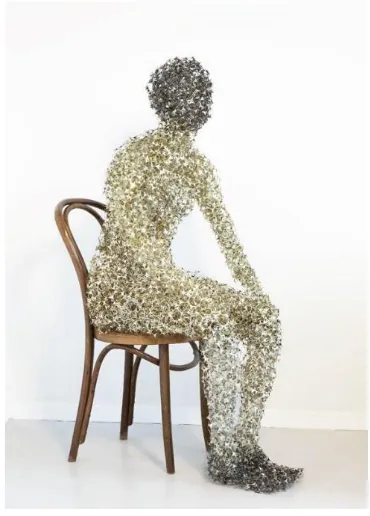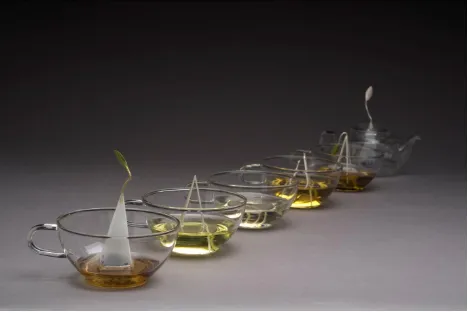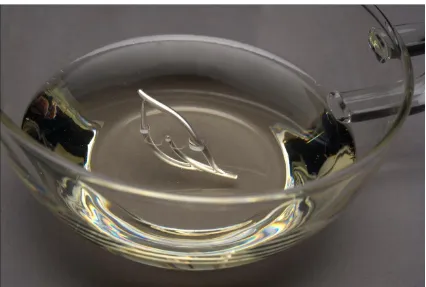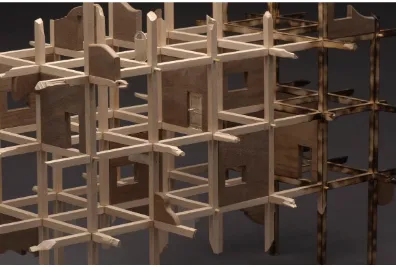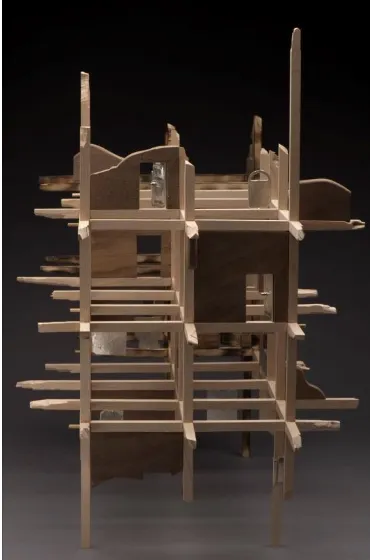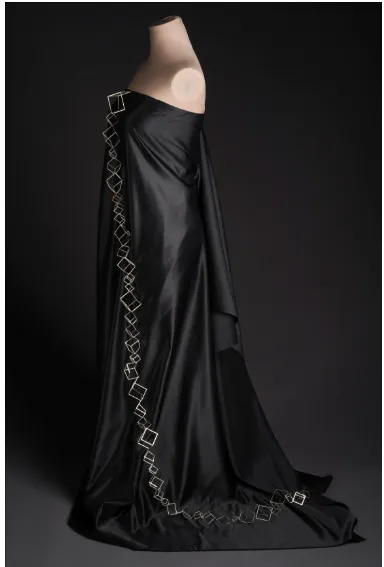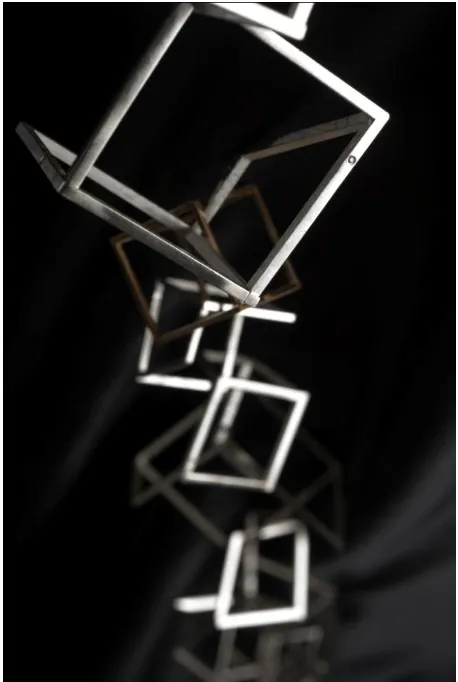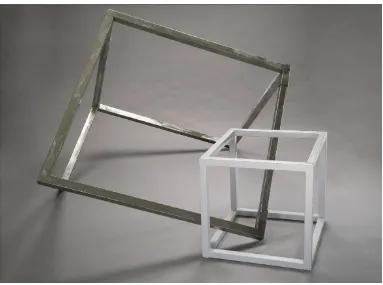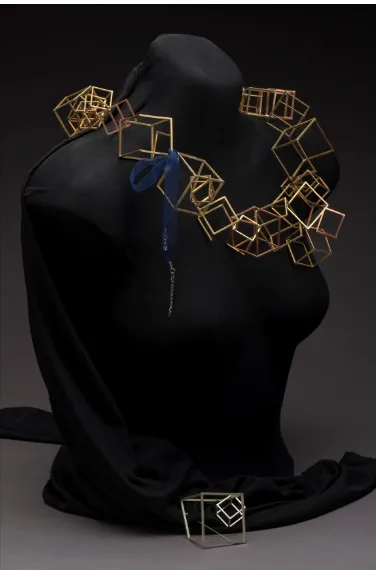Rochester Institute of Technology
RIT Scholar Works
Theses Thesis/Dissertation Collections
5-2014
Live in the Moment: The Essence of Life
Ta-Wen Huang
Follow this and additional works at:http://scholarworks.rit.edu/theses
This Thesis is brought to you for free and open access by the Thesis/Dissertation Collections at RIT Scholar Works. It has been accepted for inclusion in Theses by an authorized administrator of RIT Scholar Works. For more information, please contactritscholarworks@rit.edu.
Recommended Citation
Rochester Institute of Technology
A thesis submitted to the faculty of
The College of Imaging Arts and Sciences
In candidacy for the degree of
Master of Fine Arts in Metals and Jewelry Design
School for American Crafts
Live in the Moment: The Essence of Life
by
Ta-Wen Huang
Approvals
Chief Advisor: Leonard Urso
__________________________________________ Date: _________________
Associate Advisor: Juan Carlos Caballero-Perez
__________________________________________ Date: _________________
Associate Advisor: Alan Singer
__________________________________________ Date: _________________
School for American Crafts Chairperson: Juan Carlos Caballero-Perez
__________________________________________ Date: _________________
Signature of Author:
Contents
Approvals 1
Abstract 3
Influences 5
Inspiration 7
Body of Work 14
Figure 21
Conclusion 32
Abstract
I have thought about the essence of human life ever since I witnessed the
impermanence of people’s lives through a near-death experience I had when I was
nineteen years old. Life is a given amount of time, space, and memory, and every
person, event, and object in the universe is stored up in time, space, and memory.
These three factors combine to create the unique experience, character, and life of each
individual person.
A number of experts from different fields, as well as international celebrities,
have publicly expressed various thoughts on life. However, most of their theories are
explained with difficult words or equations. As an artist and architect, I want to depict
the appearance of human life via my understanding of these theories as well as my own
experiences. In my eyes, the complex world in which we live is composed of
geometric patterns. Every object, every room, every person, and every living creature,
from the micro to the macro, is defined by a form derived from a geometric pattern.
Nature itself is full of geometric patterns that define and redefine every structure, each
moment, and all events as they unfold.
In this thesis paper, I discuss my main influences as an artist and the
inspiration behind my thesis topic, as well as the background of each piece in my body
of work. I want to use my artwork to signify, through these patterns, that the present
moment is the most important point in time of a person’s life. The present moment is
the only thing that people can change; yet, people are constantly regretting their pasts
and planning their futures. Neither the past nor the future is changeable: we cannot
turn back time and the future does not yet exist. Therefore, the present moment is the
moment, they will be different. Our lives will be led in other directions as time moves
Influence
The most important influences on my artistic ability come from my culture and
my father. In Taiwan, children learn Chinese characters through pictures because the
basic characters of the Chinese language are derived from images. For me, looking at
Chinese characters is the same as looking at pictures. Moreover, instead of fairy tales,
my father used to read me Tang poetry1 in my early childhood. Tang poetry is
composed of antique characters and modes. At the time, I was too young to understand
antique writing, so my father told me, “ If you think words are pictures, then stories are
animations. Chinese characters came from real objects, but you have to release your
imagination when you read and write them.” I then learned to translate my
imagination into my writing, and my writing into my art.
My early life also influenced my way of thinking. My father was a teacher of
literature and drawing, but he was also an advocate of science. In order to encourage
my brother and me to involve ourselves in the sciences, my family used to watch
programs such as MacGyver and Star Trek on weekends—my first exposure to science
and science fiction. I believed that science could solve most of the world’s problems.
In my early education, I gravitated toward the sciences, especially mathematics and
physics.
While studying art, literature, mathematics, and physics at the same time, I
enjoyed switching my thoughts from one to another, even though people believe that
math and physics are diametrically opposed to art and literature. Due to my love of
both literature and science, I entered my university’s Department of Design and
graduated with a BA in architecture. Although architecture is considered a design
program, architecture students believe that they are both artists and craftsmen.
Students are trained to develop concepts and then apply their art form to the design of
buildings. These students also believe that buildings themselves are a form of
functional artwork for cities. However, I realized that being an architect actually
involves telling other people’s stories via my own design. Instead of being a translator,
I prefer to share what I myself know, feel, and see.
I consider my art to be a kind of storybook, including parables, issues, feelings,
and messages, and I am like a writer trying to simplify complicated issues for the
understanding of general readers. As in my artwork, I want to present my
understanding from the perspective of different fields, simplify complex issues, and
create solid objects. I hope my audience has the chance to access those different fields
Inspiration
I was involved in a traffic accident when I was a sophomore in college. As I
saw the car coming toward me, I had a sudden, strong sense of everything around me.
At that moment, motion suddenly froze, but memory kept welling up in my mind. I
heard the last sentences I said to my family and my friends. Many important scenes
from my life flashed through my mind and those memories were so bright. Every
scene, every event, every person, and every facial expression seemed to have been
deeply inscribed on my heart, even though I had not recalled them for a long time.
I spent a week in the hospital, during which time I thought about my situation
and what I had felt at the moment of the accident. I realized that life is very fragile: this
minor accident had reduced my capability to walk for a whole week. I had always
planned for my future, but I realized then that an accident could suddenly destroy my
plans, or even my life. The feelings I had at that moment changed me a great deal. I
used to think that if I was not in a good mood, I did not need to respond politely to
other people, even my family and friends. Since my accident, I try to be nice to the
people who are close to me each time I see them, as I really have no idea if we will
ever meet again.
In that moment, I perceived the weakness and impermanence of human life, and
the way in which life inspires people during catastrophes. This accident gave me a
chance to look at my nineteen years of life and see it as a series of choices; whether the
results are good or bad, making choices is the only way to move forward. Thus, every
choice is both a cause and an effect, and all of those causes and effects coiled together
to compose my life. The accident was an effect at that moment, but it also became an
“Life” is a gigantic and complicated word. Some religions believe in
reincarnation or in heaven and hell, and through these theories people understand the
meaning of life. However, as Confucius said, “While you do not know life, how can
you know about death?” Thus, scientists often try to find out how life first appeared in
this world. Ideas such as the Big Bang theory2 point to the sources of life, while
Darwin’s theory of evolution presents changes in living organisms. These theories
have both ideological and academic value, but I think learning about life as we know it
is what most people have to do. Indeed, everyone is constantly learning about life
every day.
Many experts from multiple scientific fields have explained life for more than a
hundred years. For example, Hermann Minkowski,3 a mathematician, used four
dimensions4 to explain life. In general, everything that is alive is also mortal: people
will die, food will rot, flowers will fade, and forms will perish. No living thing can
escape from aging. Conversely, life involves everything, including the universe,5 so not
only do philosophers, rationalists, theologians, and scientists try to decode life, but also
every person has his or her own questions about life.
Time is a basic element of life because it is the unit with which people calculate
the length of life. But what is time? Isaac Newton’s Absolute Time theory pointed out
that time is completely separate from and independent of space.6 Most people share this
common-sense view because it fits their experiences. A traditional timeline, a line with
2 Hawking, S (Placeholder1) (Placeholder1) (Hawking)tephen. and Mlodinow, Leonard. A Briefer History of Tim, chapter 8.
3 <http://www-history.mcs.st-andrews.ac.uk/Biographies/Minkowski.html>, para. 7. 4 Hawking, Stephen. and Mlodinow, Leonard. A Briefer History of Time, p. 35, para. 2. 5 Hawking, Stephen. and Mlodinow, Leonard. A Briefer History of Time, chapter 8.
single arrow symbol, is the simplest example of Absolute Time theory. Time is the
axis of life and events are just points on life’s timeline.
Time is a natively unusual concept: it is impossible to prove that it exists, but
every person knows that it exists. The idea of time passing or flying is basic to people’s
understanding of life. Then, does time exist? If there were no human-made time
measurements, the earth would go back to its natural time measurement, which is one
day. The most fundamental astronomical period we experience is a day’s journey into
night and back again. Deeply imprinted in our biology as our circadian rhythms, the
day/night, light/dark cycle sets the ebb and flow of our sleep and wakefulness.7 Yet,
the polar day and the polar night would make it difficult to measure time, because
constancy makes time meaningless. As Ian Hinckfuss said, “Time is the daddy of all
processes. It is the ‘process’ by virtue of which all other processes take place.”8 In
order to record changing processes, people created time, and it is change that provides
the illusion of time.9 From this explanation, it is easy to see that change creates and
gives value to time. Therefore, creating an art form that depicts “change” is the main
idea behind my depiction of “time.” Violent changes are apparent and sudden, but
there are many more slight changes in people’s daily lives. Although slight changes
can be easily ignored, especially when compared to violent changes, these slow
processes demonstrate the effects of time more clearly than rapid ones. Thus, I will use
the changes inherent in daily life to depict the existence of “time” in people’s lives.
Space is an indispensable element of life. People live in spaces, and every event
has to happen in a space. A “space” is also a place for storing stuff. Compared with
7Frank, Adam. About Time, p. 10
8Hinckfuss, Ian. The Existence of Space and Time, p. 63.
time, space seems easier to understand because it is a physical concept. People can
describe the shape and size of a space, whether it can really be seen or not. Space is
therefore a sort of entity, even though people cannot touch it.
I hold a BA in architecture, so space is a familiar concept to me. Architecture is
the knowledge of designing and creating spaces. Every student has to anticipate what
kind of feelings, experiences, and events the design of a space will provide. While
studying architecture, I began to understand that architecture is not only a combination
of humanities and technology, but is also a construct of the relationship between
humanity and space. Therefore, in addition to storing objects, space supplies people
with fullness of heart. In human life, meeting, feeling, and experiencing have to
happen in various spaces: the same place might appear again and again, but different
timing, people, and conversations will develop different mood and events. Thus, the
value of a space is based on its providing experiences for people. In order to address
this aspect, I created an art form that presents the relationship between life and space
by applying my background in architecture to my artwork. The relationship between
life and space is manifested in links, which appear during the movement from one
In Julie Tremblay’s Reflections10
collection, I strongly sense the combination of
[image:13.612.338.523.72.330.2]time and space. Reflections consists of 10
figures that are hand sculpted from castoff
industrial sheet metal. Each figure is posed to
convey sadness, loneliness, or happiness as
ordinary experiences in human life. The sheet
metal reflects light and makes the sculptures
transparent; this feature also creates illusions
between different modes of existence, which
vanish in a moment as afterimages. At
first, ’moments of life’ was the artistic theme I
wanted to explore; however, after my deep discovery of time and space, other elements
became apparent.
Time and space seem to be very different concepts, yet they are similar in
essence. Time arranges events, while space arranges objects. Moreover, changes
appear in a space and experiences are accumulated via time. Hermann Minkowski
considered space and time, which were formerly thought to be independent, to be
coupled together in a four-dimensional concept called space-time.11 In the space-time
of relativity, four numbers or coordinates can specify any event.12 Since each person
has one life, two people are able to meet each other by appearing in the same place at
10Julie Tremblay <http://www.craigscottgallery.com/?sec=4&news_id=60>
Reflections No
8<http://www.craigscottgallery.com/?sec=2&artist_id=27&picture_id=1011&sort_order=8 >
11 <http://www-history.mcs.st-andrews.ac.uk/Biographies/Minkowski.html>, para. 7. 12 Hawking, Stephen. and Mlodinow, Leonard. A Briefer History of Time, p. 35, para. 2.
the same time at different moments in their lives. The four-dimensional concept
provides a clear shape for the depiction of life. However, compared to reality, it is hard
to visually present the idea that I exist in one place at this moment, and even if I do not
move, in the next moment I will be in a different four-dimensional space. Thus, the
challenge of shaping this concept is how to present the essence of the
four-dimensionality of daily life.
Changes and experiences are preserved in memory. I believe that memory is
the most important part of life, and the weight of one’s life depends upon the quality
and quantity of one’s memories. As I maintained, in order to record changes, people
created the concept of time, and the secret to this is memory. The order of memories
helps people to understand that every event happens step by step, and it is the reason
that people can feel time passing.
Every choice in people’s lives depends on their memories and experiences,
since memories give people the capability of knowing right from wrong and of
predicting cause and effect. Memory is a history of each individual person; yet, it is not
only what people go through, but also what people learn, think, and dream. Learning is
remembering the experiences and achievements of our forebears, while thinking helps
people to use their memories to make better choices. Thus, memories and impressions
are the concrete evidence of life. I believe that memories are attached to objects; thus,
in an empty space, there is nothing to provide experiences and therefore nothing that
needs to be remembered. I will therefore use certain objects in my work that represent
not only my memories but also the evidence of the existence of my life.
In conclusion, in certain ways, life is like a movie: it is composed of moments in
time as a movie is composed of frames. In a movie, each frame has its own scene,
the same, they still exist individually at different points in time. In life, although every
moment relates to other moments, it still exists individually and has its own time,
space, event, and choices. The order in which time is strung together at every moment
creates a unique life for each person in the world.
In my artwork, I attempt to portray memory, time, space, and life as seen
Body of Work
Whenever (Figures 1, 2, 3, 4, & 5)
“A memory should have a moral ending: it’s its raison d’être, otherwise it’s
mere gossip.”13
I believe that slow processes demonstrate the effects of time most clearly, so
I started to look into my daily life for examples of such processes. I found that I
repeat most behaviors from day to day, such as going to school and eating
breakfast. I also found that I drink a cup of tea every day. During this activity, I
can feel time slowly passing as my sensations change slightly every second. I
love to watch the water change color and the tea leaves expand. However, I
found that I could not recall many details from my daily reenactment of this
scene.
I chose to represent tea drinking in this artwork in order to depict the slow
passing of time. By photographing my tea-drinking habit for several weeks, I
found that although I used the same cup and sat in the same place at the same
time every day, the pictures that I took were never the same. Sunshine provided
different types of light, shadow, and color, and other elements changed as well,
such as the number of tea leaves and the water.
Presenting the design of teabags, the shape of tea leaves, and the color of tea
became the challenges of this design. First of all, I tried to find teabags which fit
my concept and my character the most on the market, so I chose the teabags,
which have a clean pyramid shape, form Tea Forté14. I then tried to figure out
13 Morand, Paul. The Allure of Chanel., p. 60
how to combine them with my thought of design. Next, since this piece was
about capturing the moment, I had to keep the shape of tea leaves. How to make
the tea leaves became my first challenge. I tried casting, folding, chasing, and
using silver clay, but none of these methods worked very well. I then started to
review my other designs. Most of my works are composed of wires—which is
part of my character—so instead of making “real” leaves, I tried to represent them
symbolically. My first concern regarding tea was color and clearness; however,
the design had to be able to hold the teabags and tea leaves in the same position
without evaporating. Therefore, I chose to use clear epoxy resin, which can be
colored and will solidify and stay clear.
In creating this cup set, I designed each cup using photographs to determine
the color of the tea, the level of the water, and the spots on the teabags; the
objective was to create unique tea cups at unique moments. However, when the
tea cups were lined up, a timeline did not exist: I couldn’t figure out which one
belonged to which day. I therefore realized that even though memory is
extremely important, in the course of one’s whole life, few events will be
remembered. People accumulate memories in every moment, but they also lose
memories every moment, and many unremarkable memories eventually vanish.
Size: six-piece set of cups, 7" x 7" x 3" each
Materials: glass teaware, teabags, sterling silver, fine silver, and clear epoxy resin
Methods: chasing, soldering, and sandblasting
Multi-universe (Figures 6, 7, 8, & 9)
“The multiverse is the hypothetical set of multiple possible universes that
and energy as well as the physical laws and constants that describe them.
The term was coined in 1895 by the American philosopher and psychologist
William James. The various universe within the multiverse are sometimes
called parallel universes.”15
The multi-universe is a concept of science fiction. The basic idea of the parallel
universe is that every choice can create a universe. For example, if a person can make
three different choices at this moment, then the universe he is in will split into three
different universes.
The original design of my concept of space-time was to line up a few slightly
different cubical spaces to represent the idea that even though I occupy one point in
space-time now, in the next moment I will be at a different point in space-time. I
therefore tried to design every cubical space in this piece with furniture, a window, and
a door. The changes in these circumstances throughout the artwork represent the
concept of space-time. When I was making the entrances/doors, I realized that the
choices we make in life are like doors that provide access to other spaces. People
literally move from space to space via doors, and in life, people move forward by
making decisions. When I need to make a decision, I have to ponder the risks, just as
children may peep through a keyhole to see what is going on in the next room.
I started this piece by recording and building doors. During these processes, I
went through many different doors. I employed the idea of four-dimensional
space-time and used my background as a building designer to create the different spaces that I
went through. Meanwhile, I also realized that I always pace back and forth in a few
specific places. Yet, because every moment is unique, even if I go back the same
place, nothing in the space is the same, including me. I then have to face totally
different choices and I might see different people or events at that moment. So I found
that instead of using multiple scenes to create a form of multiverse, repeating the same
scene is actually closer to reality.
Since doors are the main idea of this piece, I started by making doors. In order
to create spaces that were different, but also similar, I chose to use sand casting instead
of handcraft. This was my first time using this method, and it was different from
regular casting. During the process, I made some defective doors (Figure 8), which fit
the idea from the first piece, “Whenever.” Although even those doors that seemed
perfect could not be exactly the same, I chose to make each separately. I then
developed simple three-dimensional graphs of geometrical cube models, which present
places in human life, and used similar walls and floors to present the same places.
Wood is one of the original materials of building. I then created a wooden structure to
represent a short span in a person’s life based on the multiverse theory. Since
according to the theory, the universe is expanding, I designed the ends of the structure
to be cut irregularly in order to evoke a feeling of continuousness, and I burned one side
to represent the past. Even though the vertical spaces are on the same time points, each
person can only appear in one space each time: whether he likes it or not he is going to
exist at the next moment.
Size: 24" x 12" x 17"
Materials: sterling silver and wood (maple and walnut)
Chain of Events (Figures 10 & 11)
The previous piece, “Multi-universe,” shows that life in the multiverse theory
is gigantic and complicated. Though the multiverse theory represents life as a gigantic
net, I think that real life may be more like a single chain, which was the inspiration for
this piece. The function of doors is to connect spaces: once a door is opened, two
spaces are attached, and people have to move forward to face other choices. In this
process, people are not able to know which choice will lead them to better places, and
the only thing to do is move forward.
In this work, I use geometric structures to symbolically represent events or
experiences—in this case, my own experiences in my life. I define the term “event” as
a scenario that includes time and space, objects and emotions. Every event connects to
other events, creating a link, and every link becomes a chain of events. Each structure I
make, in this case the cube, is not shaped perfectly as defined by its geometry, but
instead has been rearranged as a unique new structure symbolizing an event in a
person’s life. My intention is not to make a perfect representation or geometric
balance, but rather to create a new structure, defined by that moment in time and space,
becoming the event in its own unique way—the link of events that shapes a person’s
life. Moreover, I believe that everyone has had some glorious moments in their lives,
such as a graduation or a wedding. In order to present these important moments, I set
diamonds in some of the cubes (Figure 11). During the design process, I turned this
piece into a wearable accessory; this represented how time and space may change, but
life derives from the human heart. I entitled this piece “Life” because it became a
chain that emerges from the center of a person (Figure 10).
Size: 6’ long
Methods: soldering and flash setting
A Place on Time (Figures 12 & 13)
In “Chain of Events,” life is portrayed as dominated by people’s choices;
however, life also includes physiology and psychology. Psychologically, when
troubles happen in my life and I have to struggle by myself, I feel that the spaces I am
in are not as flat and stable as what I see. The feeling is like standing on a slope and
looking up at doors on the ceiling that I can see, but cannot reach.
The original piece in this design was a brooch (Figure 16). After some
discussion, I enlarged it to become a sculpture, increasing the intensity of the design
and representing my own feeling of struggle. I started with the big cube, which
represents a difficult moment in my life. This cube is made imperfectly and is placed
diagonally in order to show the crooked space, which makes it difficult for me to reach
some points and presents a space that contains choices to which I can only look up. On
the other hand, even though life is full of choices and difficulties, it does have some
quiet time, so the small cube is made whole, representing the regular movements of my
life. I made the small cube white, a calm and peaceful color, to represent an ordinary
moment, and kept the big cube the original color of steel, which has a tougher feel, in
order to demonstrate my feelings about the two different space-times.
Size: 6.5’ x 8.5’
Materials: steel
Life (Figures 14, 15, & 16)
“The only reason for time is so that everything doesn’t happen at once.”
-Albert Einstein
When I started this thesis, I tried to avoid using circles because it looked like
everything was happening all over again. However, in the process of creating this
thesis, I recalled the memories and feelings associated with my traffic accident. I felt
that life is full of choices and that all choices are both causes and effects, which coil
together to compose my life. Every choice is both an effect and a cause, so every
moment in a person’s life relates to the other moments. In my life, every choice I make
stems from my past, so I realize that every memory, movement, and choice affects who
I am at this moment—and yet, this moment is passing. In this piece, in order to
connect a visual chain of events that could record who I am, what I am thinking, and
what I understand at a given moment, I tied the beginning and the end of the chain
together with material I happened to find handy. Linking the chain in this way created a
circle to present every moment of my past create who I am now.
Size: 30" long
Materials: sterling silver, brass, spring steel, and ribbon
Figures
Figure 2 – Whenever
[image:24.612.92.521.402.685.2]Figure 4 – Whenever (detail)
[image:25.612.94.520.397.684.2]Figure 6 – Multi-universe
[image:26.612.109.507.403.670.2]Figure 8 – Multi-universe (detail)
[image:27.612.213.398.403.683.2]Figure 12 – A Place on Time
[image:30.612.116.499.407.692.2]Figure 15 – Life (detail)
[image:32.612.93.524.401.687.2]Even though I can describe my artwork quite reasonably, when I introduced my
work to viewers, some points were difficult for them to understand and for me to
explain.
1. “Whenever” and “Multi-universe” are easy to understand as shapes, but a few
viewers suggested that some images would help them to more easily grasp the
concept.
2. Although the process from “Multi-universe” to “Chain of Events” is intelligible,
some viewers thought that doors seemed to be important elements in the process.
Perhaps I should have created more work involving doors. I agree with my
viewers that I missed some important points; my thinking moved forward too
quickly. Someday, I might do some basic work with doors.
3. In “Chain of Events,” viewers had trouble with the display. Why use the figure?
They thought the display seemed designed to be pleasing to the eye. First, events
happen to humans, so I maintain that “Chain of Events” should use the human
figure as part of the display. Moreover, a compounded display might be another
choice. Second, I do not deny my consideration of beauty in this piece; from my
perspective, artwork must combine art, craft, and beauty.
4. Several viewers mentioned that “Chain of Events,” “A Place on Time,” and
“Life” have many similarities. The reason for these similarities is that the form of
the artwork strongly represents the primary concept I had at that moment;
Conclusion
As an artist, I want to share what I see, what I know, and what I think. In this
thesis, I created five pieces that reflect my life, my background, and my knowledge;
yet, each piece is a step toward my discovery of the essence of life. I also included
some scientific theories in my pieces, and I hope that, by seeing my artwork, people
can access new fields of knowledge with which they are unfamiliar.
At the conclusion of this investigation, I now think of my life in this moment as
being supported by everything that has happened to me, and I believe that the present
moment is the only moment in which I can be myself. Loss and gain are normal in
human life, so in this moment I am already different from who I was in the last. During
the present moment, I see, hear, learn, and think, and then I become a different person.
I do not excessively think about the past or anticipate the future. The past is solid fact,
which becomes nutrients for the rest of my life. As for the future, perhaps if I can
cherish every present moment, it will happen in the way I want. Thus, “live in the
moment” is what I have to learn now.
During my thesis year, I explored, researched, and studied many aspects of life,
but life has innumerable aspects. It is impossible to fully analyze and understand life in
few pages or in one year. In consideration of this effort, my next venture as an artist
and human being is to frequently recall this concept in my attempt to create new art
Bibliography
Crichton, Michael. Timeline. New York: Random House, 1999. Print.
Frank, Adam. About Time. New York: Free Press. 2011. Print.
Hawking, Stephen. The Illustrated A Brief History of Time. New York: Bantam Books, 1996. Print.
Hawking, Stephen. and Mlodinow, Leonard. A Briefer History of Time. New York: Bantam Dell, 2008. Print.
Hinckfuss, Ian. The Existence of Space and Time. Oxford: Clarendon. 1975. Print.
Hoblit, Gregory (director). Frequency. New Line, 2000. Film.
Morand, Paul. The Allure of Chanel. London: Pushkin Press. 2008. Print.
O’Connor, J. J., and Robertson, E. F. Hermann Minkowski. University of St Andrews School of Mathematics and Statistics. Scotland, May 2005. June 2010 Website.
